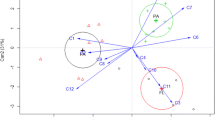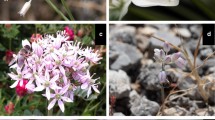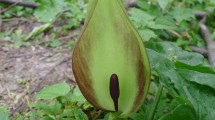Abstract
Floral scent in sapromyiophilous plants often consists of complex blends with not only fetid (e.g., sulfides) but also sweet (e.g., terpenoids) volatile organic compounds, and a recent study suggests that both groups of compounds are involved in pollinator attraction. However, little is known about the number and identity of compounds involved in pollinator attraction in these deceptive plants that mimic breeding sites of fly pollinators. In the present paper, we studied flower volatiles of sapromyiophilous Periploca laevigata and their capability to elicit biological responses in one of the pollinator species, Musca domestica. Floral volatiles were collected by dynamic headspace and analyzed by gas chromatography/mass spectrometry (GC/MS), and electrophysiological (GC/EAD) and behavioral assays (two choice olfactometer) were conducted. In the floral scent of P. laevigata, we detected 44 compounds, of which indole, β-caryophyllene, and germacrene D, as well as dimethyl trisulfide, which was present in trace amounts, were electrophysiologically active in the antennae of M. domestica. However, when we evaluated in behavioral experiments the attractiveness of the electrophysiologically active compounds (complete mixture against partial mixtures or against single compounds), we found that indole was the only attractive compound for the flies.




Similar content being viewed by others
References
Adams RP (2007) Identification of essential oil components by gas chromatography/mass spectrometry. Allured Publishing Corporation, Carol Stream, Illinois
Ao M, Liu B, Wang L (2013) Volatile compound in cut and un-cut flowers of tetraploid Freesia hybrida. Nat Prod Res 27:37–40
Asclepol database. Germany Department of Plant Systematics, University of Bayreuth. Available: http://www.uni-bayreuth.de/departments/planta2/research/pollina/as_pol_t.html. Accessed 26 July 2014
Burger H, Dötterl S, Ayasse M (2010) Host-plant finding and recognition by visual and olfactory floral cues in an oligolectic bee. Funct Ecol 24:1234–1240
Chittka L, Raine NE (2006) Recognition of flowers by pollinators. Curr Opin Plant Biol 9:428–435
Cossé AA, Baker TC (1996) House flies and pig manure volatiles: wind tunnel behavioral studies and electrophysiological evaluations. J Agric Entomol 13:301–317
Dobson HEM (2006) Relationship between floral fragrance composition and type of pollinator. In: Dudareva N, Pichersky E (eds) Biology of floral scent. CRC Press, Boca Raton, pp 147–198
Dobson HEM, Bergström G (2000) The ecology of pollen odors. Plant Syst Evol 222:63–87
Dudareva N, Negre F, Nagegowda DA, Orlova I (2006) Plant volatiles: recent advances and future perespectives. Cr Rev Plant Sci 25:417–440
El-Sayed AM (2014) The pherobase: Database of pheromones and semiochemicals. Available: http://www.pherobase.com. Accessed 04 Oct 2014
Faegri K, van der Pijl L (1979) The principles of pollination ecology. Pergamon Press, Oxford
Farré‐Armengol G, Filella I, Llusià J, Niinemets Ü, Peñuelas J (2014) Changes in floral bouquets from compound-specific responses to increasing temperatures. Glob Chang Biol. doi:10.1111/gcb.12628
Förster M, Klimpel S, Mehlhorn H, Sievert K, Messler S, Pfeffer K (2007) Pilot study on synanthropic flies (e.g. Musca, Sarcophaga, Calliphora, Fannia, Lucilia, Stomoxys) as vectors of pathogenic microorganisms. Parasitol Res 101:243–246
Ghrabi Z (2005) A guide to medicinal plants in north Africa. IUCN Centre for Mediterranean Cooperation, Malaga
Jürgens A, Dötterl S, Meve U (2006) The chemical nature of fetid floral odours in stapeliads (Apocynaceae –Asclepiadoideae - Ceropegieae). New Phytol 172:452–468
Jürgens A, Wee S-L, Shuttleworth A, Johnson SD (2013) Chemical mimicry of insect oviposition sites: a global analysis of convergence in angiosperms. Ecol Lett. doi:10.1111/ele.12152
Kite GC, Hetterscheid WLA, Lewis MJ, Boyce PC, Ollerton J, Cocklin E, Diaz A, Simmonds MSJ (1998) Inflorescence odours and pollinators of Arum and Amorphophallus (Araceae). In: Owens SJ, Rudall PJ (eds) Reproductive biology. Royal Botanic Gardens, Kew, UK, pp 295–315
Knudsen JT, Eriksson R, Gershenzon J, Ståhl B (2006) Diversity and distribution of floral scent. Bot Rev 72:1–120
Kunze J, Gumbert A (2001) The combined effect of color and odor on flower choice behavior of bumblebees in flower mimic systems. Behav Ecol 12:447–456
Larraín PS, Salas CF (2008) House fly (Musca domestica L.) (Diptera: Muscidae) development in different types of manure. Chil J Agric Res 68:192–197
Larsson MC, Stensmyr MC, Bice SB, Hansson BS (2003) Attractiveness of fruit and flower odorants detected by olfactory receptor neurons in the fruit chafer Pachnoda marginata. J Chem Ecol 29:1253–1268
McDonald JH (2009) Handbook of biological statistics, 2nd edn. Sparky House Publishing, Baltimore
Mitchell RJ, Flanagan RJ, Brown BJ, Waser NM, Karron JD (2009) New frontiers in competition for pollination. Ann Bot 103:1355–1363
Moré M, Cocucci AA, Raguso RA (2013) The importance of oligosulfides in the attraction of fly pollinators to the brood-site deceptive species Jaborosa rotacea (Solanaceae). Int J Plant Sci 174:863–876
Morey RA, Khandagle AJ (2012) Bioefficacy of essential oils of medicinal plants against housefly, Musca domestica L. Parasitol Res 111:1799–1805
Mulla MS, Hwang YS, Axelrod H (1977) Attractants for synanthropic flies: chemical attractants for domestic flies. J Econ Entomol 70:644–648
O’Neil MJ (ed) (2013) The Merck index: An encyclopedia of chemicals, drugs, and biologicals, 15th edn. Cambridge, RSC Publishing
Pisciotta S, Raspi A, Sajeva M (2011) First records of pollinators of two co-occurring Mediterranean Apocynaceae. Plant Biosyst 145:141–149
Raguso RA (2008) Wake up and smell the roses: the ecology and evolution of floral scent. Annu Rev Ecol Evol Syst 39:549–569
Schäffler I, Balao F, Dötterl S (2012) Floral and vegetative cues in oil-secreting and non-oil-secreting Lysimachia species. Ann Bot 110:125–138
Schiestl FP (2010) The evolution of floral scent and insect chemical communication. Ecol Lett 13:643–656
Shuttleworth A, Johnson SD (2010) The missing stink: sulphur compounds can mediate a shift between fly and wasp pollination systems. Proc R Soc London B Biol Sci 277:2811–2819
StatSoft Inc. (2013) STATISTICA (Data Analysis Software System), Version 12. http://www.statsoft.com
Stensmyr MC, Urru I, Collu I, Celander M, Hansson BS, Angioy A (2002) Rotting smell of dead-horse arum florets. Nature 420:625–626
Tholl D, Boland W, Hansel A, Loreto F, Röse USR, Schnitzler JP (2006) Practical approaches to plant volatile analysis. Plant J 45:540–560
Urru I, Stensmyr MC, Hansson BS (2011) Pollination by brood-site deception. Phytochemistry 72:1655–1666
van der Niet T, Hansen DM, Johnson SD (2011) Carrion mimicry in a South African orchid: flowers attract a narrow subset of the fly assemblage on animal carcasses. Ann Bot 107:981–992
Woodcock TS, Larson BMH, Kevan PG, Inouye DW, Lunau K (2014) Flies and flowers II: floral attractants and rewards. J Pollin Ecol 12:63–94
Zito P, Sajeva M (2012) Periploca laevigata Aiton subsp. angustifolia (Labill.) Markgraf on Lampedusa Island. Asklepios 113:3–16
Zito P, Guarino S, Peri E, Sajeva M, Colazza S (2013) Electrophysiological and behavioural responses of the housefly to “sweet” volatiles of the flowers of Caralluma europaea (Guss.) N.E. Br. Arthropod Plant Interact 7:485–489. doi:10.1007/s11829-013-9270-3
Zito P, Sajeva M, Raspi A, Dötterl S (2014) Dimethyl disulfide and dimethyl trisulfide: so similar yet so different in evoking biological responses in saprophilous flies. Chemoecology 24:261–267. doi:10.1007/s00049-014-0169-y
Acknowledgments
We thank Dr Irmgard Schäffler for methodological support and constructive discussions, Mr Guaraci Duran Cordeiro for help during the captures of flies, and owners of the horse barn for agreeing to perform the captures on their property. We thank the staff of Riserva Naturale Orientata Isola di Lampedusa for the assistance and the logistic support during the collection of the volatiles of Periploca laevigata.
Author information
Authors and Affiliations
Corresponding author
Electronic supplementary material
Below is the link to the electronic supplementary material.
Electronic Supplementary Material – ESM 1
Amount of EAD-active compounds in Periploca laevigata subsp. angustifolia flowers and released during our biotests. The presence of these compounds in organic matter and sapromyiophilous plants, and their capability in eliciting biological response in flies is also given (according to Jürgens et al. 2013). (DOC 48 kb)
Rights and permissions
About this article
Cite this article
Zito, P., Dötterl, S. & Sajeva, M. Floral Volatiles in a Sapromyiophilous Plant and Their Importance in Attracting House Fly Pollinators. J Chem Ecol 41, 340–349 (2015). https://doi.org/10.1007/s10886-015-0568-8
Received:
Revised:
Accepted:
Published:
Issue Date:
DOI: https://doi.org/10.1007/s10886-015-0568-8




